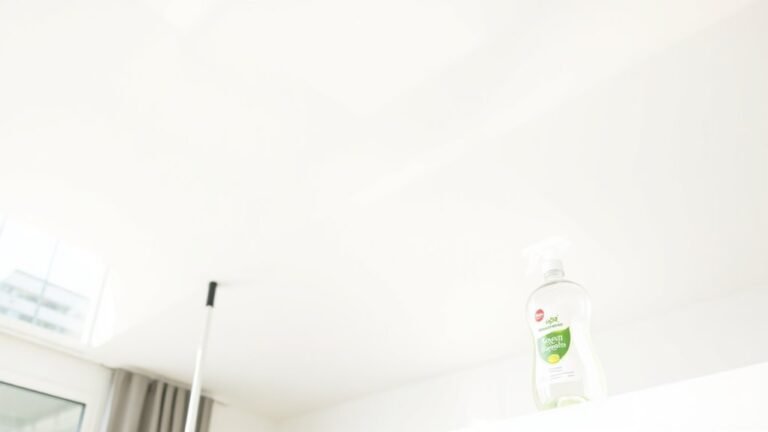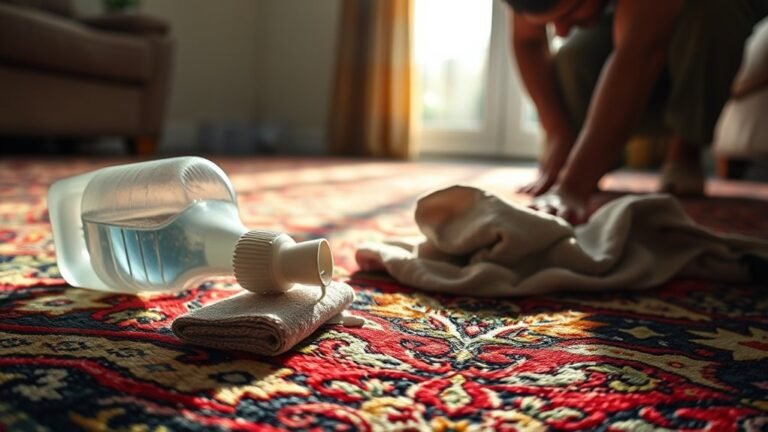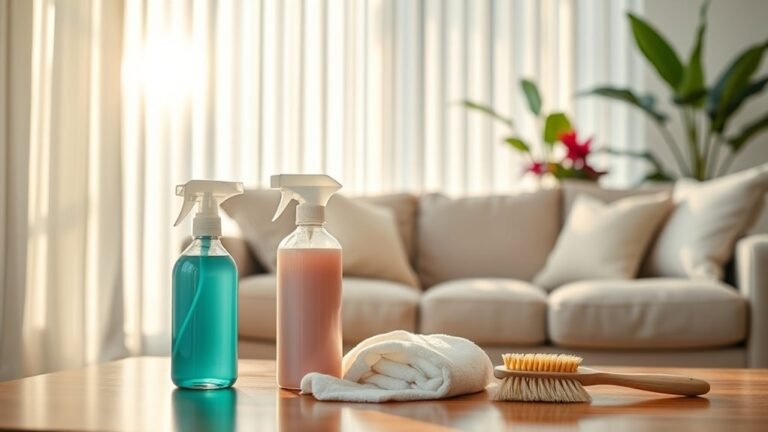How to Clean Your Home After Toys
To clean your home after toys, start by sorting them by type and size to keep things organized. Use labeled storage bins for easy access and quick cleanup. Set a daily routine and involve your kids, making cleanup a fun, shared activity. Create dedicated play areas and consider multi-functional furniture to save space. Regularly clean and sanitize toys to keep things fresh. Keep these simple habits in mind to transform toy cleanup into a stress-free habit you’ll appreciate.
Sort Toys by Type and Size

Sorting toys by type and size is the best way to start cleaning up your home efficiently. When you use effective toy classification methods, you gain control over clutter quickly, freeing up space and your mind. Group similar toys—like action figures, building blocks, or plush animals—together, then separate them by size to make everything easy to find. This simple organizational strategy helps you maintain order without feeling overwhelmed. You’ll appreciate how much easier it becomes to locate items and put them away, giving you more freedom to enjoy your space. By adopting these clear, practical steps, you’re not just tidying up—you’re creating a system that supports a relaxed, clutter-free lifestyle. Sorting smart means less stress and more freedom for what truly matters.
Use Storage Bins and Labels
Once you’ve grouped the toys, using storage bins with clear labels can make cleanup a breeze. These storage solutions not only keep toys contained but also help you quickly identify where everything belongs. Choose bins that are durable and easy to access, so you’re not stuck fumbling during cleanup time. Labels are key—they provide visual cues that simplify organization and make it easier for everyone to pitch in. You can use pictures or words, depending on who’s helping out. Incorporating these organization tips transforms toy cleanup from a chore into a quick, manageable task. With a clear system in place, you free up time and space, allowing you to enjoy a tidy home without feeling tied down by clutter.
Establish a Daily Cleanup Routine

Creating a daily cleanup routine can save you hours of frustration each week. By setting simple, consistent habits, you free up time and reduce clutter stress. Use daily reminders—like phone alerts or notes—to keep cleanup top of mind. Pair these with cleanup incentives to motivate yourself, such as enjoying a favorite show only after tidying up.
Keep your routine manageable by focusing on key tasks:
- Quickly sorting toys into labeled bins
- Wiping down play surfaces
- Putting away stray items before bedtime
This approach helps maintain order effortlessly. Over time, cleanup becomes second nature, turning what once felt like a chore into an easy part of your day, giving you the freedom to enjoy a clean, calm home without constant effort.
Involve Your Kids in the Cleanup Process
You can make cleanup time enjoyable by turning it into a game or challenge for your kids. Assign tasks that match their age and abilities to keep them engaged without feeling overwhelmed. This way, they’ll learn responsibility while having fun helping out.
Make Cleanup Fun
Although cleaning up toys might seem like a chore, turning it into a game can make the process enjoyable for your kids—and for you. You can spark their enthusiasm by introducing toy themed games and cleanup challenges that turn tidying into a fun activity rather than a dull task. Try these ideas:
- Race against a timer to see who can pick up the most toys
- Pretend the floor is lava and only certain spots are safe for placing items
- Create a scavenger hunt where kids find and sort toys by color or type
Assign Age-Appropriate Tasks
Assigning just the right tasks based on your child’s age can make cleanup smoother and more effective. When you match age responsibilities to their abilities, you empower your kids to take ownership without feeling overwhelmed. For toddlers, simple jobs like putting blocks in a bin work well, while older kids can handle sorting toys or wiping surfaces. Task delegation becomes a tool for teaching responsibility and independence, not just a way to get chores done. By clearly defining what each child can manage, you create a fair system that respects their freedom and skills. This approach turns cleanup from a hassle into a shared, manageable routine, freeing you from the burden of doing it all yourself while fostering your kids’ growth.
Incorporate Multi-Functional Furniture

You can save space and reduce clutter by choosing furniture that does more than one job. Look for pieces with hidden storage to tuck away toys quickly and easily. This way, your space stays tidy, and your furniture works harder for you.
Space-Saving Solutions
One of the smartest ways to keep your home tidy after playtime is by using multi-functional furniture that saves space. This approach helps you embrace minimalist decor while maximizing vertical storage, freeing up floor space and reducing clutter. You’ll love how these pieces blend practicality with style, giving you more freedom to enjoy your living areas without constant mess.
Consider these space-saving solutions:
- A storage ottoman that doubles as seating and a toy chest
- A wall-mounted foldable desk with shelves for books and games
- A bunk bed with built-in drawers and shelving for toys and clothes
Hidden Storage Options
Building on space-saving furniture, hidden storage options offer a clever way to keep toys out of sight while maintaining easy access. You can use under bed storage containers to slide away toys effortlessly, freeing up floor space and reducing clutter. These containers are perfect for stashing puzzles, dolls, or building blocks without sacrificing room. Decorative baskets also provide a stylish, functional solution. Placed in living areas or bedrooms, they blend seamlessly with your décor while keeping toys organized and within reach. Choosing multi-functional furniture, like ottomans or benches with built-in storage, lets you enjoy freedom from mess without extra steps. With these hidden storage options, you’ll find it easier to keep your home tidy, creating a calm environment where both you and your kids can relax and play.
Versatile Design Benefits
Anyone looking to maximize space and functionality will appreciate the benefits of multi-functional furniture. With versatile storage and adaptable designs, you can keep your home tidy without sacrificing style or freedom. These pieces effortlessly transform to meet your needs, giving you the flexibility to store toys and other items while maintaining an open, uncluttered space. Imagine:
- A coffee table that doubles as a toy chest with hidden compartments
- A bench with built-in storage for books and games
- Shelving units that adjust height and configuration as your needs evolve
Clean and Sanitize Toys Regularly
Although it might seem tedious, cleaning and sanitizing toys regularly is essential to keep your home healthy and germ-free. You want to protect your family without feeling trapped by endless chores. Start by choosing safe cleaning products designed specifically for children’s items—avoiding harsh chemicals guarantees toys stay safe and durable. Explore various toy sanitization methods like wiping with mild soap and water, using disinfectant sprays approved for toys, or even running washable toys through the dishwasher. Consistency is key; set a routine that fits your lifestyle, so cleaning doesn’t feel like a burden. By maintaining clean toys, you’re not only reducing germs but also creating a freer, more enjoyable space for play. It’s a small effort that makes a big difference.
Create a Dedicated Play Area
When you set up a dedicated play area, you make it easier to keep toys organized and your home tidy. Creating dedicated zones gives your kids freedom to play while you enjoy less clutter and stress. The play area benefits both your family’s routine and your peace of mind by containing messes to one spot. Choose a space that’s visible and accessible, so you can supervise without hovering. Use practical storage solutions like bins or shelves to keep toys sorted and off the floor.
Here are a few ideas to visualize your dedicated play area:
- A cozy corner with a soft rug and toy baskets
- Wall-mounted shelves for easy access and display
- Bright, cheerful décor that invites creativity
This setup lets you relax, knowing toys have their own happy place.
Frequently Asked Questions
How Can I Remove Stubborn Stains From Toy Surfaces?
If you want effective stain removal on toy materials, start by identifying what the toy’s made of—plastic, fabric, or wood. You can’t just use any cleaner. Use a mild soap and warm water for most plastics, but for fabric toys, a gentle stain remover works best. Avoid harsh chemicals to keep the materials safe. Don’t forget to test a small area first to make sure you don’t damage the toy.
What Is the Best Way to Clean Electronic Toys Safely?
When cleaning electronic toys, you’ll want to prioritize battery care by removing batteries before you start. Use a soft cloth slightly dampened with a mild disinfectant to gently wipe surfaces—avoid soaking to protect internal components. For electronic disinfecting, opt for wipes designed for gadgets or a mixture of water and isopropyl alcohol. This way, you can keep toys clean and safe without risking damage, giving you the freedom to enjoy worry-free playtime.
How Often Should I Deep Clean the Play Area?
You should aim to deep clean your play area every one to two weeks to keep things fresh and safe. Setting up a cleaning schedule helps with consistent play area maintenance, preventing buildup of dirt or germs. Of course, if your kids have been extra messy or sick, don’t hesitate to deep clean more often. This way, you maintain a healthy, inviting space without feeling trapped by constant chores.
Are Natural Cleaning Products Safe for Children’s Toys?
Imagine a garden where every flower blooms untouched by harsh storms—that’s what using natural cleaning products on toys feels like. You’re choosing eco friendly options that protect your child’s world without the shadow of chemical safety concerns. These gentle cleaners keep playtime safe and free, letting your little one explore with joy and freedom, while you rest easy knowing the environment and their health are both cared for naturally.
How Do I Prevent Mold Growth on Stuffed Animals?
To prevent mold growth on your stuffed animals, focus on mold prevention by keeping them dry and well-ventilated. After washing, make sure they’re completely air-dried or use a low-heat dryer setting. Store them in breathable containers to avoid moisture buildup. Stuffed animal care also means regularly checking for damp spots and cleaning them gently with natural products. This way, you’ll keep your toys fresh and mold-free without restricting your freedom to enjoy them.






